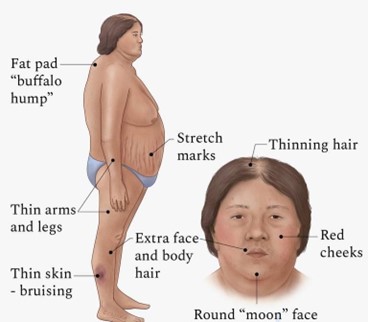A nurse is collecting data from a client who has Cushing’s syndrome. Which of the following findings should the nurse expect?
Weight loss
Diaphoresis
Hyperpigmentation
Hypotension
The Correct Answer is C
Choice A reason: Weight loss is not a symptom of Cushing’s syndrome. On the contrary, weight gain and obesity are common signs of this condition, especially in the trunk, face and upper back1.
Choice B reason: Diaphoresis, or excessive sweating, is not a symptom of Cushing’s syndrome. It can be caused by other conditions, such as hyperthyroidism, menopause or anxiety.
Choice C reason: Hyperpigmentation, or darkening of the skin, is a symptom of Cushing’s syndrome. It occurs due to increased production of melanin, the pigment that gives color to the skin. Hyperpigmentation can affect any part of the body, but it is more noticeable in areas exposed to friction or pressure, such as the elbows, knees, knuckles and armpits.
Choice D reason: Hypotension, or low blood pressure, is not a symptom of Cushing’s syndrome. In fact, high blood pressure (hypertension) is one of the common symptoms of this condition, due to the effects of cortisol on the cardiovascular system.

Nursing Test Bank
Naxlex Comprehensive Predictor Exams
Related Questions
Correct Answer is B
Explanation
Choice A reason: Shock is not a cause of acute pancreatitis, but a possible complication of severe cases that can lead to organ failure and death.
Choice B reason: Gallstones are one of the major causes of acute pancreatitis, as they can block the pancreatic duct and prevent the flow of digestive enzymes, leading to inflammation and damage of the pancreas.
Choice C reason: Diabetes mellitus is not a cause of acute pancreatitis, but a possible complication of chronic pancreatitis, as the damage to the pancreas can impair its ability to produce insulin and regulate blood sugar levels.
Choice D reason: GERD (gastroesophageal reflux disease) is not a cause of acute pancreatitis, but a condition that affects the lower esophageal sphincter and allows stomach acid to reflux into the esophagus, causing heartburn and other symptoms.

Correct Answer is B
Explanation
Choice A: Weigh the client weekly. This is incorrect because the client receiving PN should be weighed daily, not weekly, to monitor fluid balance and nutritional status. The nurse should also measure the client’s intake and output, blood glucose, electrolytes, and other laboratory values daily.
Choice B: Reduce the rate of the solution gradually to discontinue. This is correct because the nurse should taper off the PN solution slowly to prevent rebound hypoglycemia, which can occur when the high concentration of glucose in the PN solution is abruptly stopped. The nurse should follow the provider’s orders or the facility’s protocol for reducing and discontinuing PN.
Choice C: Remove solution from refrigerator 2 hr before infusion. This is incorrect because the nurse should remove the PN solution from the refrigerator 30 to 60 minutes before infusion, not 2 hr, to allow it to reach room temperature. Infusing a cold solution can cause discomfort, vasoconstriction, and impaired absorption of nutrients.
Choice D: Shake the solution before hanging if there is a layer of fat present on the top. This is incorrect because the nurse should not shake the PN solution at all, as this can cause fat emulsion droplets to coalesce and form large particles that can clog the filter or cause embolism. The nurse should gently invert or roll the PN solution container to mix it if there is any separation of components.
Whether you are a student looking to ace your exams or a practicing nurse seeking to enhance your expertise , our nursing education contents will empower you with the confidence and competence to make a difference in the lives of patients and become a respected leader in the healthcare field.
Visit Naxlex, invest in your future and unlock endless possibilities with our unparalleled nursing education contents today
Report Wrong Answer on the Current Question
Do you disagree with the answer? If yes, what is your expected answer? Explain.
Kindly be descriptive with the issue you are facing.
